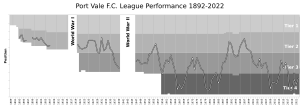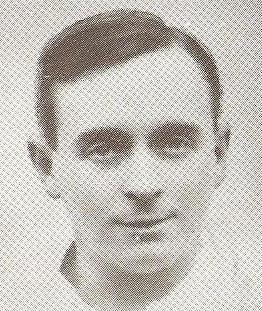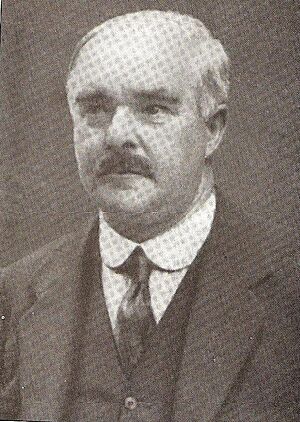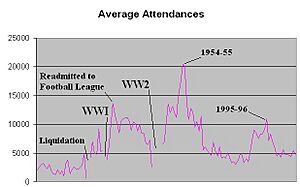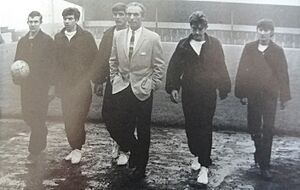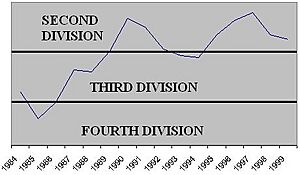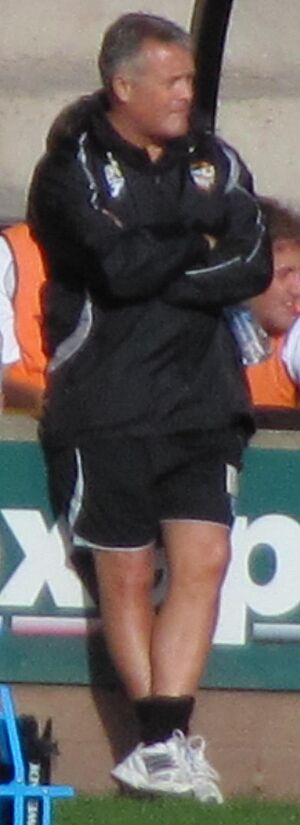History of Port Vale F.C. facts for kids
The history of Port Vale Football Club is a long and exciting journey. This English football club is based in Stoke-on-Trent. It officially started in 1876, but some research suggests it might have been 1879.
In 1884, the club moved to Burslem, a town in Stoke-on-Trent. They changed their name to Burslem Port Vale. The club joined the Football League Second Division in 1892. They played many seasons there, sometimes dropping to the Midland League.
A big money problem in 1907 led to the club closing down. But the name "Port Vale F.C." lived on! A local team called Cobridge Church took the name. They moved to the Old Recreation Ground in Hanley. They worked their way up and rejoined the Football League in 1919.
They spent many years in the Second Division. In 1929–30, they won the Third Division North title. This was amazing, even after selling their top scorer, Wilf Kirkham. In 1950, the club moved to Vale Park. They had to sell their old ground to pay off debts.
The 1953–54 season was special. Vale won the Third Division North title. They also reached the semi-finals of the FA Cup. Manager Freddie Steele's team had a famous "Iron Curtain" defence. After a tough period, new manager Norman Low led them to win the Fourth Division title in 1958–59.
The 1960s were difficult. In 1968, Stanley Matthews left as manager. The club faced problems and had to ask to stay in the Football League. But then, manager Gordon Lee helped them get promoted in 1969–70. They spent most of the 1970s in the third tier.
John Rudge became manager in 1983. He stayed for 16 years, a golden age for the club. Vale won promotion from the Fourth Division in 1985–86. They also moved up from the third tier in 1988–89 and 1993–94. They even won the Football League Trophy in 1993.
After Rudge left in 1999, the club struggled. They dropped to the fourth tier. They also faced serious money problems twice, in 2003 and 2012. Norman Smurthwaite saved the club from these problems in 2012. Manager Micky Adams helped them get promoted from League Two in 2012–13. However, they were relegated back to League Two in 2016–17.
Carol Shanahan bought the club in 2019. Manager Darrell Clarke led them to promotion from the League Two play-offs in 2021–22. Sadly, Vale were relegated again at the end of the 2023–24 season.
Contents
- The Club's Beginning: 1876 or 1879?
- Early Years and Joining the League (1879–1907)
- A New Beginning: The Wilderness Years (1907–1919)
- Back with the Big Teams (1919–1929)
- Pre-War Ups and Downs (1929–1939)
- World War II and Coming Back Strong (1939–1950)
- New Stadium, New Triumphs (1950–1959)
- The Sixties: A Challenging Decade (1959–1969)
- Struggling On (1969–1983)
- The Rudge Era: A Golden Age (1983–1999)
- Challenges and Comebacks (1999–2011)
- New Owners and New Challenges (2012–Present)
The Club's Beginning: 1876 or 1879?
The exact start of Port Vale Football Club is a bit of a mystery. For a long time, people thought the club began in 1876. This was believed to have happened at a place called Port Vale House. However, no one has ever found proof of a building with that name.
Historian Jeff Kent did a lot of research. He thinks the club probably started in 1879. It might have come from another team called Porthill Victoria. The name "Port Vale" likely came from its location. It was in a valley near canal ports.
Old records from 1907 show the club chairman saying the club was 28 years old. This would mean it started in 1879. Also, many of the club's first players would have been too young to play in 1876. For many years, people thought 1879 was the start date. But in 1926, the club celebrated its 50-year anniversary. This made 1876 the official founding year. It's still not clear why that date was chosen.
Another idea is that Port Vale was formed by combining other local teams. But there isn't much proof for this. Some old bricks have "Burslem Port Vale" on them. This led to a theory that the club started as a brickworks team. However, these names probably just showed where the bricks were made.
The name "Port Vale" is quite unique. The players lived near places like Port Vale Wharf and Port Vale Street. Since a nearby team played on a hill, it made sense for the valley team to be called Port Vale.
Early Years and Joining the League (1879–1907)
The club first played football at Limekiln Lane in Longport. Later, they moved to Westport Meadows in Westport. The club quickly became the strongest team in Burslem. They even had a reserve team by 1880. They started charging people to watch their games.
On 2 February 1884, Port Vale won a friendly match 16–0 against Middlewich. Soon after, two Vale players were chosen to play for Staffordshire. People started to see Port Vale and Stoke as the two most important football clubs in the area.
In 1884, the club moved to Burslem. They played at a new ground on Moorland Road. They beat Everton 6–0 in their first game there. The club then changed its name to Burslem Port Vale. In 1885, they moved to the Athletic Ground. They also started paying their players regular wages.
In 1888, Port Vale tried to join the new English Football League but didn't succeed. Instead, they joined a league called The Second Combination. In 1890, they became founding members of the Midland League. After finishing third in 1891–92, they were finally voted into the new Football League Second Division in 1892.
Their first League season was tough. They lost 10–0 at home to Sheffield United in a snowstorm. This is still a Football League record. They finished near the bottom but were allowed to stay in the league. After a few more difficult seasons, they were voted out of the League in 1896. They spent two more years in the Midland League.
In 1898, the Football League grew bigger. Port Vale was voted back in, partly because they had beaten top-tier Sheffield United in the FA Cup. However, the club still had money problems. They often had to sell their best players to survive. In 1907, the club decided to leave the League. They felt they couldn't continue.
|
|
| The kit used in Vale's first League season (1892) |
A New Beginning: The Wilderness Years (1907–1919)
Burslem Port Vale officially closed down in 1909. But the story didn't end there! A local team called Cobridge Church had big plans. In 1907, they asked the FA if they could change their name to Port Vale. They also bought the old club's ground, the Athletic Ground.
The new Port Vale started in a minor league. But they quickly moved up. Money problems still affected the club. In 1908, former Vale player Sam Bennion led a group to buy the club. Some old players, like Adrian Capes, came back. Things started to look better.
In 1909–10, the club won the North Staffordshire & District League. But they lost key players like Joe Brough to bigger clubs. In 1911, the club joined the Central League. Facing more money troubles and issues with their ground, Vale moved to The Old Recreation Ground in 1912. This new stadium in Hanley could hold over 10,000 fans.
In 1914, Vale agreed to step aside from the Football League. This was to help their rivals Stoke get back into the League. It was hoped Stoke would return the favour later. Tom Holford, a former Stoke player, became the new player-manager. The club stopped playing in 1914–15 because of World War I.
After the war, in March 1919, the club failed to get back into the League. However, in October 1919, they got a chance. Leeds City was disbanded due to money problems. Port Vale took over their fixtures in the Second Division. They were back in the Football League!
Back with the Big Teams (1919–1929)
During this time, Port Vale started to look more like the club we know today. Around November 1920, chairman Frank Huntbach gave the club its famous nickname: "the Valiants." In 1921, the club started wearing its well-known white and black kit. Before this, they had tried many different colours, even red and white stripes like their rivals Stoke!
In February 1921, their star striker Bobby Blood was sold for a huge £4,000. In 1922, Wales international goalkeeper Teddy Peers joined. He was the first Port Vale player to play for his country while at the club.
However, money problems returned. In 1923, the club was fined for making illegal payments to players. Sadly, in November 1923, player Tom Butler died after getting hurt on the pitch. The club, with help from other teams, raised money for his family. Wilf Kirkham was the club's top scorer for three seasons in a row.
In 1926, the club's directors thought about joining with rivals Stoke City. But Vale fans didn't like this idea at all. Stoke also decided against it. In 1929, Port Vale was relegated to the Third Division North for the first time. To make things worse, Kirkham was sold to Stoke.
Pre-War Ups and Downs (1929–1939)
In the 1929–30 season, only the champions of the Third Divisions would get promoted. Selling Kirkham allowed Vale to improve other parts of the team. Manager Joe Schofield sadly died in September 1929, but Vale was still top of the league. Reserve team coach Tom Morgan took over.
The club continued its great form and won the league title! They had the best defence in all four divisions. The 1930–31 season was one of the club's best ever. They finished fifth in the second tier, thanks to a strong defence. After the season, they even went on a mini-tour of the Netherlands.
But money was still tight. They sold top scorer Sam Jennings and Phil Griffiths for £6,000. The new team struggled. They narrowly avoided relegation in 1931–32. Manager Tom Morgan was replaced by Tom Holford again.
The club kept selling players to make money. Wilf Kirkham left to become a teacher. Despite financial struggles, they had a strong season in 1933–34, finishing eighth. But it was a financial disaster. Many players were let go or sold.
In 1934–35, there was talk of changing the club's name. Names like 'Stoke Central' were suggested. They even settled on 'Hanley Port Vale' for a short time. But fans didn't like it, and the idea eventually faded away.
Vale was relegated in 1935–36. They sold their top striker Tom Nolan. Manager Holford talked about focusing on young players. Warney Cresswell became manager in 1936–37, aiming for promotion. But after a mid-table finish, he left. More players were sold.
In December 1937, Tom Morgan became manager again. The 1937–38 season was another average one. Jack Roberts scored 28 goals, which was a highlight. For the 1938–39 season, the club moved to the Third Division South. This was good news, as it meant more money from ticket sales. But injuries hit the squad, and they struggled to avoid relegation.
World War II and Coming Back Strong (1939–1950)
When World War II started in Europe, the 1939–40 football season was cancelled. Many players went off to fight. Port Vale couldn't play in the war leagues because of money problems and losing players. They managed to keep a youth team going, which did well locally.
The death of chairman Major W.M.Huntbach left the club in a lot of debt. They had to sell The Old Recreation Ground to the city council for £13,500 in 1940. This left the club without a home and no professional players during the war. However, the council later allowed them to rent the ground until 1950.
By 1944, the club had brought back its first team. They also found a place in Burslem for a new stadium and started raising money for it. Jack Diffin became the team manager. When the war ended, the 1946–47 season began. Morris Jones scored 26 goals, and the club finished tenth. It was also their best financial year, making over £4,000 profit.
Jones was sold in 1947. The club finished eighth in 1947–48 but lost money overall. The 1948–49 season was not very exciting, but the club made record profits of over £7,000. Selling Bill Pointon for a large sum helped a lot.
In 1949–50, the club had many players, but only a few were full-time professionals. The signing of young Ray King and defender Lol Hamlett was important. The team finished mid-table. Most of the talk was about the new stadium being built in Burslem. Selling Ronnie Allen for £20,000 also raised a lot of money.
New Stadium, New Triumphs (1950–1959)
In 1950, Vale Park was finished. The 1950–51 season was the first at their new home. The stadium was impressive, but the team struggled to get out of mid-table. Players had to get used to the much bigger pitch. A new player, Roy Sproson, joined the club. In March, Bill McGarry was sold for £12,000. He later played for the England team.
The club was still working on the new stadium, especially fixing drainage problems. They didn't buy many new players for the 1951–52 season. Manager Ivor Powell was sacked in December. On Christmas Eve, Freddie Steele became manager. He helped the club finish safely in mid-table.
Steele quickly became a success. He created the famous 'Iron Curtain' defence. He worked with the young players already at the club. In 1952–53, the FA moved the club to the Third Division North. Vale finished just one point behind the champions, Oldham Athletic. They only let in 35 goals in 46 games, which was amazing.
The 1953–54 season was incredible. Vale won the Third Division North title. They also reached the FA Cup semi-finals. They lost to West Brom in a very close and controversial game. The attendance at Villa Park for that game was 68,221. The defence, including Ray King and Roy Sproson, was key to their success. They only let in 21 goals in 46 league games, which is still a Football League record. Only five of those goals were scored at Vale Park!
The club continued its policy of not buying or selling many players in 1954–55. They struggled to score goals. The average home attendance of 20,708 that season is still a club record today. In January 1956, the club broke its transfer record. They bought former England international Eddie Baily for £7,000.
The 1956–57 season was a disaster. The club was relegated with only 22 points. Norman Low replaced Freddie Steele in February 1957, but it didn't help much. The team only scored four goals away from home all season.
The 1957–58 season was important. The bottom teams from both Third Divisions would be relegated to a new Fourth Division. Low made many changes to the team. New player Stan Steele scored 22 goals. But it wasn't enough, and Vale finished 15th, meaning they went into the new fourth tier.
Their first season in the Fourth Division was a huge success. The club won the title, scoring a club record 110 goals! Norman Low highlighted three star players: Graham Barnett, Ken Hancock, and Stan Steele. With five forwards scoring many goals, and more fans coming to games, there was a lot of hope for the future.
The Sixties: A Challenging Decade (1959–1969)
On 9 January 1960, Port Vale had one of their best performances ever. They beat high-flying Second Division club Cardiff City 2–0 in the FA Cup. They also beat Scunthorpe United 1–0 in the next round. In the fifth round, they lost 2–1 to Aston Villa. Their good cup form didn't carry over to the league, and they finished mid-table in 1959–60.
In 1960–61, the club tried to sign Gerry Hitchens for £10,000. In January, Albert Leake left, leaving Roy Sproson as the only player from the famous 1953–54 team. Stan Steele, who had played 195 games in a row, was rested and then sold for £10,000. Cliff Portwood scored 26 goals, helping the club finish seventh.
For 1961–62, Steele was bought back. But Cliff Portwood was sold for £6,000. Manager Low believed the team could get promoted. In October, 22,895 fans watched Czechoslovakia beat Port Vale 3–1. In January, Vale visited Second Division Sunderland in the FA Cup. Almost 50,000 fans watched a 0–0 draw. In the replay, Vale won 3–1 in a "magical" game. They lost to top-flight Fulham in the next round. The season ended with another mid-table finish.
A poor start to 1962–63 led to manager Low resigning. Surprisingly, old boss Freddie Steele was brought back. The "Steele curtain" defence returned, and the team went 525 minutes without letting in a goal. Top scorers Bert Llewellyn and Arthur Longbottom were sold. In March, Tony Richards was bought for £9,000. He amazingly became the season's top scorer with 13 goals in just three months. Vale finished third, just missing out on promotion.
The club spent a lot of money in 1963–64 to try and win promotion. They bought Billy Bingham and Albert Cheesebrough for £15,000 each. They also bought Tim Rawlings and Ron Smith. Jackie Mudie and Ron Wilson joined from Stoke City. They did well in the FA Cup, taking Liverpool to a replay. But the league season was a disaster. Despite spending nearly £50,000 on players, they finished much lower than the previous season. The club lost a lot of money.
The club struggled badly in 1964–65. Goalkeeper Ken Hancock was sold for £10,000. Freddie Steele left in February. Jackie Mudie became caretaker manager. The club was relegated in 22nd place. They scored the fewest goals in the Football League. To save money, many players left for free. The club lost about £15,000, and home attendance was very low.
Stanley Matthews became general manager in 1965–66. He focused on developing young talent. Over 700 boys were given trials. John Nicholson made a club record 208 games in a row before being dropped. He was then sold for £5,000. That money was used to bring in Jimmy Hill. Four teenagers made their debuts in one game. Malcolm MacKenzie became the youngest player ever for the club at 15 years old. The club finished 19th, just two points from safety. They lost nearly £30,000 that season.
After a good start to 1966–67, top scorer John Rowland was sold for £6,500. A feeling of sadness spread over the club due to debt and the death of former player John Nicholson. The season faded away. John Ritchie was sold for £17,500 to help pay off a large debt. Jackie Mudie resigned as player-manager. The club finished mid-table and lost money. Roy Sproson was given the first Player of the Year award.
Many players left before the 1967–68 season. The departure of young Ray Kennedy would be regretted later. The club also sold Terry Alcock for £25,000. Two new players, Roy Chapman and Mick Morris, joined for free. In November, the FA started investigating the club for breaking rules about player payments. By January, the investigation looked into claims of paying "amateurs" and schoolboys, and illegal bonuses.
In February, the club admitted to the charges. They were fined £2,000, which was later doubled. They were also told they would have to apply to stay in the Football League at the end of the season. On 8 June, they were allowed to stay. Stanley Matthews left, and Gordon Lee became manager. In 1968–69, Lee earned respect for his honest approach. The club stayed in the league. Football hooliganism started to appear, and Vale saw their rivals' team bus smashed. At the end of the season, the club was in debt.
Struggling On (1969–1983)
In the summer of 1969, there were talks about bringing speedway racing to Vale Park. But many people were against it. The idea was stopped when the council didn't give permission. Port Vale managed to get out of the fourth tier and into the third in 1969–70. They finished fourth, thanks to a strong defence. The club's chairman was arrested in February for a non-football matter and resigned.
The most important new player for 1970–71 was Brian Horton. Soon after, four of the club's directors resigned. Long-serving player Ron Wilson also left. The club made a rare profit, but fans were unhappy with a lower mid-table finish.
Manager Lee largely kept the same squad for 1971–72. He warned fans that low attendance would force him to sell his best players. The season was mostly unmemorable. Money was raised by selling some land and Tony Lacey. The club legend Roy Sproson made his final appearance in front of a small crowd. Lee was frustrated by the low turnouts.
Many long-serving players were released for 1972–73. New signings included Ray Williams. After a big 7–0 loss, the team went on a run of five wins. Lee continued to complain about the fans. Vale lost 1–0 to West Ham United in the FA Cup. The violence of a few supporters was a problem. In January, John James was sold for £5,000. They finished sixth, just missing promotion.
Before 1973–74, Sammy Morgan was sold for over £20,000. The defence was made stronger with new signings. In January, Lee left to manage Blackburn Rovers. Roy Sproson became his replacement. Sproson wanted a more "entertaining" style of play. The club finished poorly but avoided relegation. New signings for 1974–75 included Terry Bailey. The club pushed for promotion but finished sixth again, four points away. Their away form cost them.
A bad financial situation meant seven players were released for 1975–76. Attempts to sign Wales internationals failed. Mick Cullerton was in great scoring form. The promotion campaign failed, and Horton was sold for £30,000, which helped the club make a profit. For the club's 100-year celebration, they played Stoke City, drawing 1–1.
The small squad barely changed for 1976–77. The FA fined the club for poor discipline. Terry Lees was sold for £25,000. Ken Beamish was bought for £12,000. Former England international Bobby Thomson was made captain. The club was known for its physical style of play. In the FA Cup, they lost to a crowd of nearly 50,000 at Villa Park. They stayed in the third tier by only three points.
Before the 1977–78 season, several players and coaches left. Manager Roy Sproson was sacked in October. After a short time with caretaker manager Colin Harper, Bobby Smith was appointed. In January, Neville Chamberlain became the club's first black professional. John Froggatt was bought for £10,000. The club was relegated to the Fourth Division in 21st place.
Seven players were released before the 1978–79 season. Manager Bobby Smith left, and Dennis Butler took over. Forward Bernie Wright came in for £9,000. In August, the club broke its transfer record, paying £37,000 for Ken Todd. Several players were sold, and others were bought. The new players didn't settle well. The club lost £52,000 that season. The chairman stepped down.
The 1979–80 season started with six straight losses. Manager Dennis Butler left, and Alan Bloor became caretaker manager. He tried to change things by dropping Bernie Wright. Bloor was given the job permanently. In December, the club got its first shirt sponsorship deal. However, Bloor resigned, saying he wasn't good enough. John McGrath took over and appointed John Rudge as his assistant. McGrath fined players for bad behaviour. He also listed fifteen players for transfer. The club barely avoided relegation. Their 20th-place finish in the Fourth Division was their worst ever.
Despite many players leaving, only two new players joined for 1980–81. Little progress was made, and the club finished 19th. They also lost 3–0 to a non-league team in the FA Cup. McGrath noted that the team's attitude was slowly improving. Record low attendance figures led to a financial loss.
McGrath tried to re-sign Brian Horton for 1981–82. Ernie Moss and Geoff Hunter were the most notable new signings. McGrath said that forwards were more important now, as wins were worth three points instead of two. For the first time in ten years, the club reached the second round of the League Cup. Colin Tartt was re-signed for £15,000 as the club pushed for promotion. Injuries stopped them from getting promoted. They finished 7th, which gave hope. But a club record low attendance of 1,924 was recorded for a league game. The club lost £65,000.
Another clear-out left only eleven professional players for the 1982–83 season. Important new players included John Ridley and Wayne Cegielski. In August, Mark Chamberlain and Mark Harrison were sold to rivals Stoke for £180,000. The club had to sell them due to money problems. Five players made their debuts in the first game of the season. McGrath tried to sign Mick Channon but failed. He settled for Bob Newton. The season ended with promotion! They finished third with seven points to spare. The club also made a profit of over £100,000, ending seven years of losses.
For 1983–84, Eamonn O'Keefe was signed for £10,000. The summer was filled with reports of players not signing contracts and being unhappy. McGrath's tactics at the start of the season were very attacking, leading to poor results. The club went eighteen games without a win. McGrath complained about the board's lack of support. On 26 November, Vale lost 7–0 at Burnley on television. By December, Port Vale was nine points from safety. On the 6th, McGrath was suspended.
The Rudge Era: A Golden Age (1983–1999)
John Rudge took over as manager in December 1983. This was after John McGrath was sacked. Rudge said he couldn't change things overnight, but he brought an "amazing transformation." The club won four home games in a row. The gap to safety shrunk from nine to four points. By March, they had escaped the relegation zone. However, a poor end to the season saw the club relegated in 23rd place.
Positive signs included a £50,601 profit and the rise of young striker Mark Bright. But Bright left in the summer for £33,000. Top scorer Eamonn O'Keefe also wanted to leave but couldn't.
Rudge made the club more stable. He cut the wage bill by £20,000. Young Robbie Earle started to show his talent. Veteran Alistair Brown was the top scorer with 21 goals. A mid-table finish was good, considering Rudge was rebuilding the team. In May 1985, young Welshman Andy Jones was bought for £3,000. Defender John Williams joined for £12,000.
Vale was promoted back to the third tier in 1985–86. They finished fourth, losing only once at Vale Park. They had an eighteen-game unbeaten run. Jones and Earle scored many goals. The only negative was a financial loss of £79,474. In the summer of 1986, new players included goalkeeper Mark Grew and midfielder Ray Walker. Rudge turned down a management job at Preston North End.
A big change happened before the 1987–88 season. Chairman Jim Lloyd stepped down, and Bill Bell took over. Long-serving player Russell Bromage left. Striker Darren Beckford joined for £15,000. Paul Smith was sold for £40,000. Then, Andy Jones was sold for a club-record £350,000. This money helped buy new full-back Simon Mills. The season was boosted by a famous 2–1 FA Cup win over top-flight Tottenham Hotspur. The cup run and player sales led to a record profit of £410,239.
A boost for 1988–89 came from selling an unused training ground for £164,800. Defender Dean Glover was signed for a club-record £200,000. The club finished third, missing automatic promotion due to goal difference. However, they won in the play-offs, beating Bristol Rovers to get promoted.
Back in the Second Division for the first time in over twenty years, Rudge strengthened the team. He signed Neil Aspin for £150,000 and striker Nicky Cross for £125,000. The 1989–90 season saw many improvements to Vale Park. On the pitch, the team did well. They also had a great FA Cup run, beating Derby County. They finished eleventh in the league. Supporters were happy as rivals Stoke City were relegated, making Vale the "top team in the Potteries" for only the second time.
Only one new player, Derek Swan, joined for the 1990–91 season. The club thought about building a new ground, but the idea was too expensive. The club finished fifteenth. Darren Beckford was again the top scorer with 23 goals. They then went into a slump, leading to relegation on the final day of the 1991–92 season. In 1992–93, Vale just missed out on promotion, losing in the play-off final to West Bromwich Albion.
Vale bounced back with two important new players. Ian Taylor, signed for £15,000 from a non-league team, and Dutch player Robin van der Laan (signed for £80,000) became key. With Martin Foyle back fit and experienced Bernie Slaven up front, Vale moved to second place. They secured promotion on the final day with a 3–1 win at Brighton. They also beat then–Premiership side Southampton 1–0 in the FA Cup. Taylor became Rudge's first £1,000,000 sale. The money was spent on bringing Steve Guppy and Gareth Griffiths to the club in 1994–95. Vale finished seventeenth, avoiding relegation. Van der Laan was sold for £475,000. Jon McCarthy and Lee Mills also joined before the 1995–96 season.
During the 1995–96 season, Vale struggled. They had only one win in their first ten league games. They were near the bottom of the table. Their home form was the worst in years. But the FA Cup helped them. They drew with promotion-chasing Crystal Palace, then won the replay. This set up a trip to cup-holders Everton. Vale drew 2–2 at Goodison Park, with Ian Bogie scoring at the very end. In the replay, Vale won 2–1, with Jon McCarthy scoring the winner.
Vale reached the fifth round, playing Leeds United. Leeds was a top-ten Premiership side. The game at Elland Road was a 0–0 draw. In the replay, Leeds won 2–1. However, Vale's cup success earned them the FA's Giantkillers award for the 1995–96 season. The cup run seemed to inspire Vale in the league. They had five wins in a row, moving up to twelfth place.
Vale also did well in the Anglo-Italian Cup. They reached the final at Wembley. Vale won 5–3 at Italian side Perugia, with Lee Mills scoring three goals. They beat Ipswich Town 4–2 in the English semi-final. A 3–1 win against West Brom in the second leg of the English final meant they played Italian winners Genoa in the final. Genoa won 5–2.
Vale had a slow start to the 1996–97 season. They had only two wins in their first ten league games. They did well in the League Cup, beating local rivals Crewe Alexandra 5–1. A protest against chairman Bill Bell seemed to improve the team's performances. In December, they had three wins in a row, including a 6–1 home win against Norwich City. Despite selling Steve Guppy for £800,000, Vale's form stayed steady. Five wins from mid-March to mid-April gave them a chance for the play-offs. But losses to Stoke City and Wolves ended their hopes. Vale's eighth-place finish was their highest since 1931.
The eighth-place finish was the peak of Vale's success under John Rudge. The next season, 1997–98, saw them in a more familiar mid-table position. Another FA Cup tie saw Vale draw with eventual winners Arsenal at Highbury. The replay at Vale Park was 1–1, with Wayne Corden scoring. Arsenal eventually won 4–3 on penalties. After three straight losses, Vale was in deep relegation trouble. But goals from Martin Foyle, Jan Jansson, and Lee Mills led to a 4–0 win at Huddersfield. This saved them from relegation at the expense of Manchester City and Stoke City. The 1998–99 season started with an early League Cup loss. After sixteen years as Port Vale manager, John Rudge was sacked in January 1999.
Challenges and Comebacks (1999–2011)
Brian Horton, a former player, replaced Rudge. The club faced money problems and poor results. Horton made five new signings on transfer deadline day, costing £1,000,000. Vale managed to avoid relegation on the final day for the second year in a row. They stayed up because they had scored more goals than Bury. However, there was no escape in 1999–2000. Huddersfield sealed Vale's fate, and Vale was relegated by thirteen points.
A worsening financial crisis threatened the club's future by the end of 2000. Vale was in the relegation zone of the Second Division. After an FA Cup loss to a non-league team, it looked like another relegation. Fans protested against chairman Bill Bell. But things changed after the new year. Brian Horton's team improved their league form. They finished in the top half and won the Football League Trophy in 2001. This included a record of sixteen matches unbeaten.
After winning the League Trophy, Vale lost veteran players Tony Naylor and Allen Tankard. Young players like Steve Brooker and Marc Bridge-Wilkinson stepped up. But Vale struggled with consistency and finished fourteenth in 2001–02. Fans were unhappy with how the club was run. A supporters' trust called "Valiant 2001" tried to buy the club. The next season, 2002–03, Vale's money problems became very serious. With early exits from both cup competitions, chairman Bill Bell called in administrators. The club was about £1.5 million in debt.
Valiant 2001 eventually took control of the club. Bill Bratt became the new chairman. Money was still tight, but the club felt more positive. On the pitch, veteran striker Brett Angell scored seven goals, helping the club stay above the relegation zone. But due to money problems, Angell couldn't stay. Vale slipped into the bottom four in March. With the threat of closing gone, and Horton signing experienced Adrian Littlejohn, Vale's form improved. They finished seventeenth.
2003–04 was a new era. The club was out of administration and owned by fans. Ticket prices were lowered, and about 3,000 season tickets were sold. Brian Horton built a young, fast team. The club had its best start to a season in years. They were top of the table in September. They looked set to challenge for the play-offs. Their strong position was thanks to their attacking players: Billy Paynter, Adrian Littlejohn, Steve Brooker, and Stephen McPhee.
Despite some success, Horton left in February 2004. The board said he wouldn't get a new contract with the same terms. His budget would be cut. Former player Martin Foyle replaced him. Horton left the team in seventh place, just outside the play-offs. This is where the club finished. On the final day, Vale needed a big win to reach the play-offs. They won 2–0, but other results meant they missed out on goal difference.
Foyle managed the club for almost four years. The team's style of play didn't always help them. They finished 17th and 13th in his first two full seasons. The club's best recent cup achievements came in 2006. Vale reached the 4th round of the FA Cup in 2005–06. They lost 3–1 to Premier League Aston Villa.
The next season, the club set a record in the League Cup. They beat three Championship teams at home. This set up a game against Spurs. Vale took the lead and were close to a big upset. But Spurs equalized and won 3–1 in extra time. The signing of Leon Constantine was a big success. He scored 19 goals before Christmas 2006. With Akpo Sodje, Vale was doing well in League One in 2006–07. But poor form saw them finish 12th. An FA Cup loss to League Two Hereford United made fans lose patience with Foyle.
A poor start to the 2007–08 season led to Foyle's dismissal in November 2007. Vale was in deep relegation trouble. Lee Sinnott took over, but he couldn't stop the club from dropping into League Two. They also lost to an 8th-tier club in the FA Cup. Financially, the club lost £383,738.
2008–09 was Vale's first season in the bottom tier in over twenty years. A special offer on season tickets led to 6,400 being sold. But the season didn't go well. Sinnott was sacked in September 2008. Dean Glover took over as caretaker manager and then permanently. Glover initially saw an improvement in form.
But poor form returned. The club lost in the FA Cup. They slid back into the lower mid-table. In 2009, fans started to question the board. The 2008–09 season ended with the club in 18th place. A new manager was announced for the 2009–10 season, with Dean Glover stepping down. The club lost £280,000 but cut player wages a lot.
On 4 June 2009, Micky Adams became the new manager. Adams made a strong start. In his second match, Vale beat Championship side Sheffield United 2–1 in the League Cup. This was only the third time the club had won away against a team two leagues above them. They also beat Sheffield Wednesday 2–0 in the next round. After three losses in seven days, Adams put his whole squad on the transfer list. He said it was a "psychological game." They climbed into the play-off places but finished tenth.
History repeated itself for 2010–11. Adams led Vale to another win against a team two tiers higher. Justin Richards scored twice in a 3–1 win at Queens Park Rangers in the League Cup. Adams left the club in December 2010 to manage his hometown club, Sheffield United. Vale was second in the table.
Jim Gannon was appointed to finish the promotion job. Vale lost ground during this change. In February, Gannon and his assistant had a big argument, which made headlines. Gannon was sacked in March after only ten weeks. This was the shortest reign for a permanent manager. Mark Grew couldn't get the club back into the play-offs. But at the end of the season, fans were happy to hear that Micky Adams would return as manager.
Adams became director, and chairman Bill Bratt resigned. This, along with promised investment, calmed unhappy fans. In September 2011, investors were revealed to be Blue Sky International. They planned to invest millions into the club. Bratt resigned as a director in October 2011. However, it soon became clear that the deal was in trouble. The new chairman and CEO faced criticism. In December, Blue Sky's CEO said his company had not invested any money. Fans showed their disapproval. By the end of the year, the CEO had resigned, and the chairman's time was ended.
New Owners and New Challenges (2012–Present)
Hopes for promotion in 2011–12 ended when the club faced a winding-up petition in February 2012. They couldn't pay tax bills or staff wages. The club went into administration on 9 March. On 6 July, it was reported that Keith Ryder had taken over. But after two months of delays, the administrators talked to other parties.
Paul Wildes completed his takeover of the club on 20 November 2012. The 2012–13 season was a big success. Tom Pope scored 33 goals, helping Vale get promoted back to League One with a third-place finish.
Paul Wildes stepped down as chairman. Norman Smurthwaite replaced him in May 2013. The club continued to do well in the league in 2013–14. They finished ninth in League One. Adams left the club after a poor start to the 2014–15 season. His assistant, Rob Page, led Vale to mid-table finishes in 2014–15 and 2015–16. He then left to manage Northampton Town.
Smurthwaite appointed the club's first foreign manager, Bruno Ribeiro, in June 2016. A mostly new squad of foreign players arrived. The result was relegation back into League Two at the end of the 2016–17 season. Michael Brown was caretaker manager after Ribeiro left. Smurthwaite apologized for the relegation and said he would step down as chairman.
A terrible start to the 2017–18 season led to Brown being sacked in September. The club was bottom of the Football League. Former defender Neil Aspin took over. John Rudge returned as director of football. They managed to avoid another relegation. But the 20th-place finish was still one of the lowest in the club's history. Aspin resigned in January 2019. John Askey came in and kept the club out of the relegation zone. Smurthwaite threatened to put the club into administration if no buyer was found. This was avoided when Carol and Kevin Shanahan bought the club.
The 2019–20 season ended early due to the COVID-19 pandemic. Carol Shanahan, now sole chairperson, voted to end the league early to help other clubs financially. This was despite it costing Vale a chance at the play-offs. John Askey left as manager in January 2021. David Flitcroft became the club's first director of football. Darrell Clarke was appointed as manager.
Port Vale's game against Harrogate Town on 5 April 2021 was the first in the English Football League with a woman referee. The team finished mid-table in 2020–21. But the club was praised for its community work. They were named Community Club of the Year for delivering 300,000 food parcels during the pandemic.
Despite manager Clarke being away for almost three months due to a family loss, Port Vale finished fifth. They qualified for the play-offs at the end of the 2021–22 season. They beat Swindon Town on penalties in the semi-finals. Promotion was secured with a 3–0 victory over Mansfield Town in the final. Clarke dedicated the win to his daughter. Clarke was sacked in April 2023 after a long period of poor results. His assistant, Andy Crosby, took over. He kept the club up but was sacked in February 2024. Darren Moore became the new manager. Vale was relegated to League Two at the end of the 2023–24 season.
|


